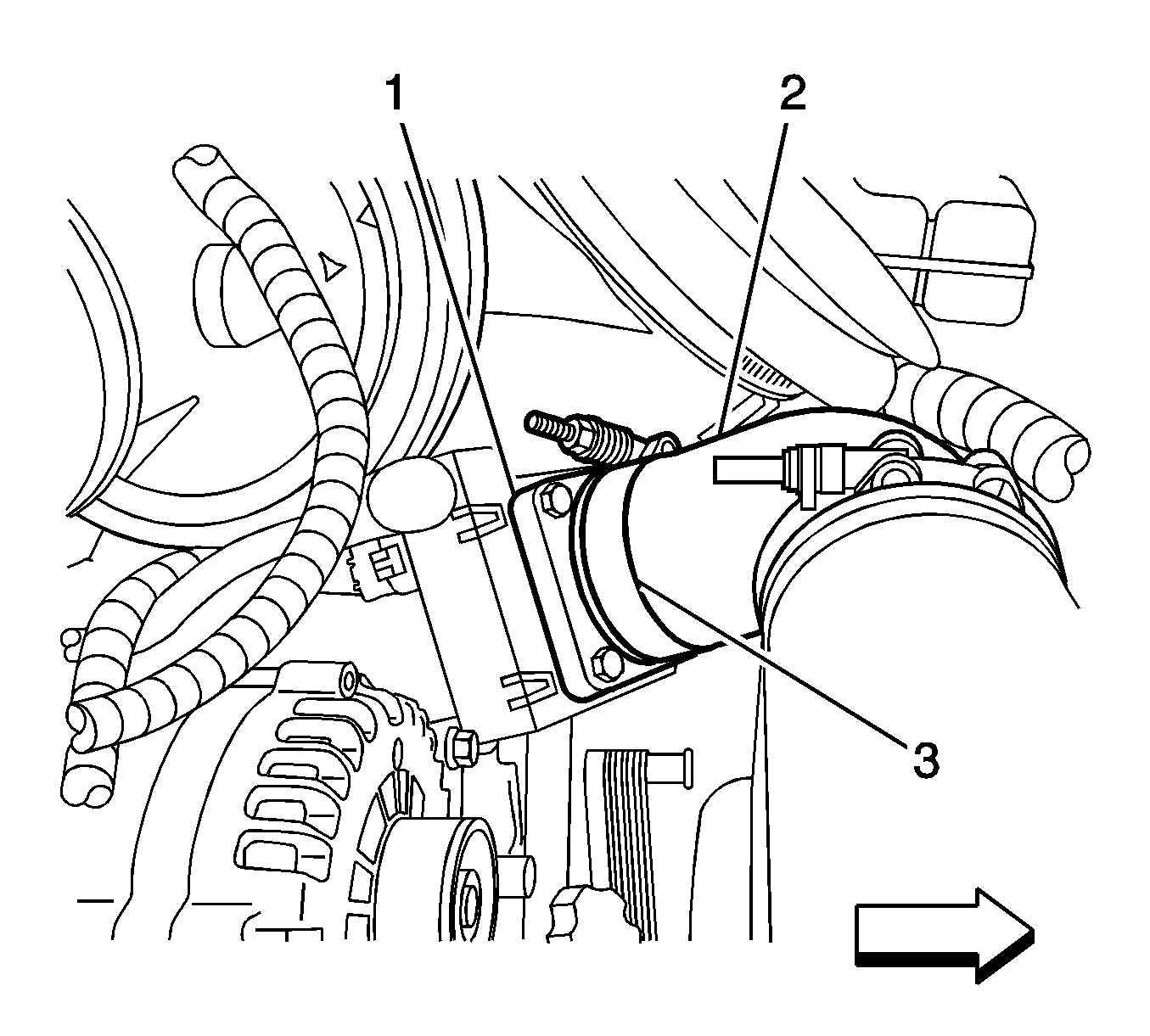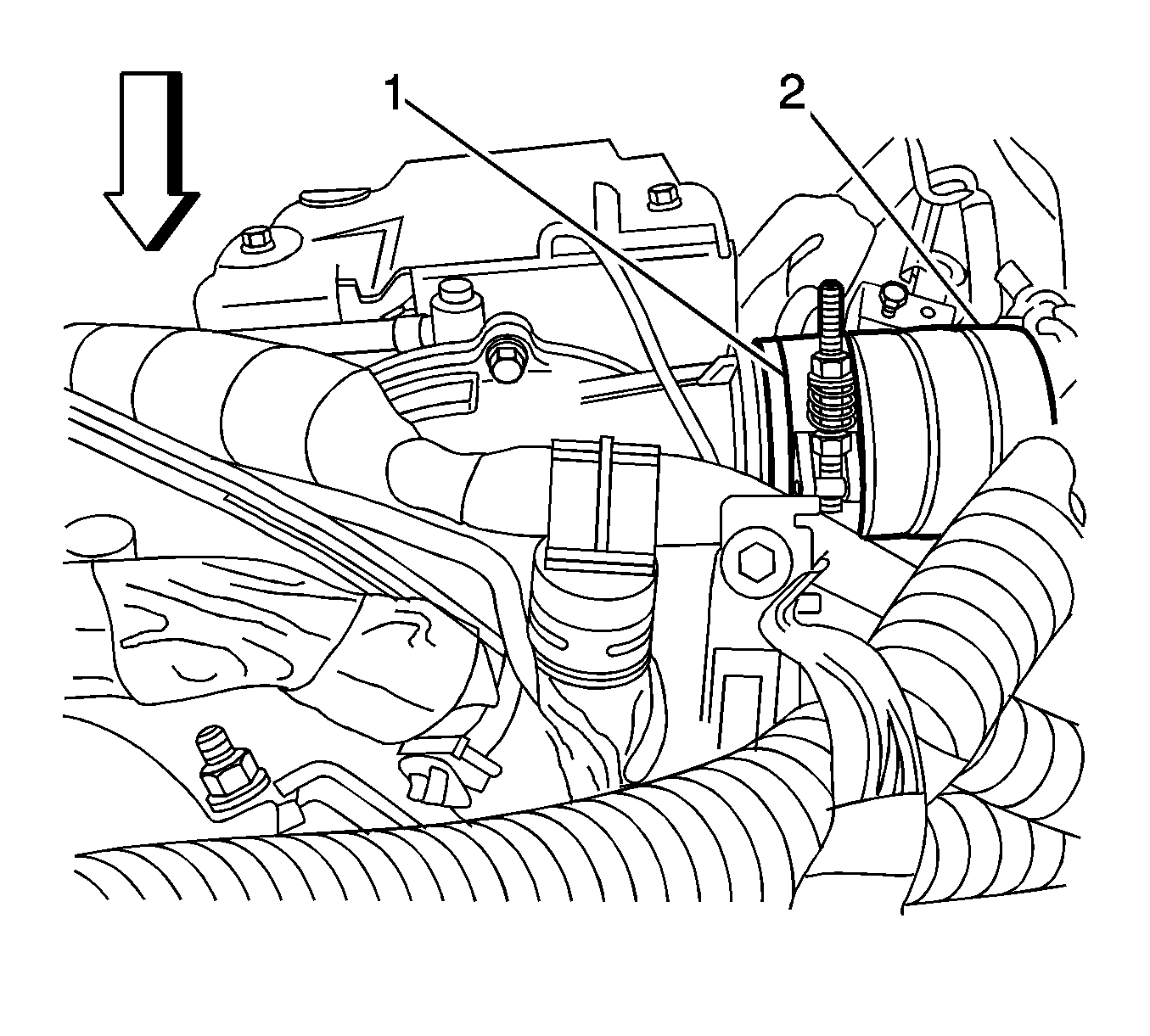Charge Air Cooler Diagnosis Charge Air Cooler Air Leak Test
Special Tools
| • | J 46091 Charge Air Cooler Tester |
| • | EN-47603 Compression Gage Adapter |
J 46091-1 Pressure Regulator Adjustment
Important: Some J 46091-1 regulators may have the adjusting knob riveted in place. The rivet head must be drilled out with a 5/16 inch drill bit before adjustment. Do not drill more than 1/8 inch in depth, or just enough to remove the rivet head. The rivet shaft does not have to be removed from the regulator.
- Connect the EN-47603 compression adapter to the J 46091 gage set and connect shop air to the J 46091 .
- Open the shutoff valve, then slowly turn the regulator on the J 46091 clockwise until the gage reads 206 kPa (30 psi).
- Close the air supply valve and remove the EN-47603 from the gage assembly.
- The gage set is now calibrated to perform the test.
Charge Air Cooler Outlet Connection (Engine Air Intake COLD Side)

Important: It is not necessary to remove the charge air cooler from the vehicle to perform this test.
- Loosen the charge air cooler (CAC) clamp (3) that fastens the right air cooler duct to the intake air heater.
- Remove the right charge air cooler duct (2) from the intake air heater inlet.
- Install the J 46091 Charge Air Cooler Tester pressure adapter to the charge air duct.
- Use the clamp to secure the adapter to the charge air duct.
- Secure the safety cable.
Important: After removing the charge air cooler duct, cover the intake heater opening (1) with tape in order to prevent entry of objects.
Tighten
Tighten the torque the clamp to 8 N·m (70 lb in).
Caution: To prevent possible injury from the coupler blowing off the charge air cooler hose during the test, connect the safety cable before applying air pressure.
Charge Air Cooler Inlet Connection (Engine Air Intake HOT Side)

- Remove the air cleaner. Refer to Air Cleaner Replacement .
- Loosen the right clamp that fastens the left air cooler duct to turbocharger (1).
- Remove the left charge air cooler inlet duct connector (2) from the turbocharger.
- Use the clamp to attach the gage couple to the charge air hose.
- Secure the safety cable.
- Attach the gage/regulator assembly to the quick disconnect fitting on the gage coupler.
Important: After removing the air cleaner assembly, protect the engine opening with tape in order to prevent entry of objects.
Important:
• After removing the charged air cooler duct, cover the turbocharger opening with tape in order to prevent entry of objects. • Do not use a screw driver or other tool to pry the hose loose. The hose can be torn or damaged. Loosen the hose by twisting.
Tighten
Torque the clamp to 8 N·m (70 lb in).
Caution: To prevent possible injury from the coupler blowing off the charge air cooler hose during the test, connect the safety cable before applying air pressure.
Leak Test -- Air Pressure Application
Caution: To prevent possible injury from the coupler blowing off the charge air cooler hose during the test, connect the safety cable before applying air pressure.
Important: Charge air coolers are not required to be leak proof. DO NOT test the cooler for leakage by submerging it in a radiator test tank. Almost all charge air cooler units will show leakage if they are submerged.
- Connect the filtered air supply to the air valve on the gage/regulator assembly.
- Open the air valve SLOWLY, increasing the air pressure in 34-69 kPa (5-10 psi) increments while listening for air leaks. Continue increasing the air pressure until the gage reads 205 kPa (30 psi).
- Close the air valve and monitor the gage for 15 seconds. Note any decrease in air pressure.
- Repeat the test 3 times to verify the results.
Leak Test Fails
If the pressure drop is more than 34 kPa (5 psi) in 15 seconds, the leak test has failed. Perform the following procedure:
- Inspect for air leaks using a pump spray bottle to apply a soapy solution to the pipes/hoses, charge air cooler hose connections, and charge air cooler core. Observe for bubbles.
- Replace or tighten the affected component as necessary.
- Retest the CAC system. If no other leaks are found, assemble the vehicle and clear the DTC information with a scan tool.
Leak Test Passes
If the pressure drop is less than 34 kPa (5 psi) in 15 seconds, the leak test passes. Remove the tester by performing the following procedure:
- Slowly bleed the air from the cooler by depressing the relief valve on the adapter plate.
- Remove the air hose, gage/regulator assembly, and both adapters.
- Connect the charge air hose to the turbocharger.
Tighten
Torque the clamp to 8 N·m (70 lb in).
